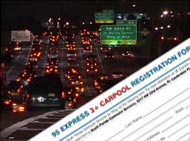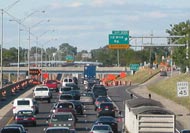Repeating their only song, the Alamo Regional Mobility Authority Chairman Bill Thornton, appointed by Rick Perry to promote toll roads at any cost, continues it’s mantra that toll opponents, specifically TURF is to blame for the 281 project costs going up. Their plan is unraveling, and they have to resort to lies to try and fool the public into supporting their billion dollar house of cards.
In fact, the very same day Thornton made these comments, the RMA Board called a special meeting to discuss (and they’ll take action at their next meeting) a $95 million loan that will cost the taxpayers $700 million in interest! The RMA can’t get the financing together for the 281 toll road, so they’re having to grasp at very risky, very expensive loan deals to hold together their sinking ship. Even board member Bob Thompson, their latest convert, expressed deep reservations about going into debt for 7 times the amount of the actual loan, so did Jim Reed. Calling it usury is no exaggeration! Who’s causing the costs of this project to escalate out of control? Certainly not the citizens!
Last week after the Sunset Commission and legislators slammed TxDOT (watch it here) for NOT following the legislative intent of a law they passed to prohibit FREEway to tollway conversions like they’re doing on 281, and AFTER they witnessed TxDOT lie under oath in full color on this video, it’s no wonder the tollers are getting desperate.
No lawsuit was filed until December of 2005, two years AFTER TxDOT had the gas taxes to expand 281 and add overpasses and frontage roads. When Cintra-Zachry got involved, the project cost escalated rapidly.
The toll road size got bigger and more expensive when TxDOT tried to skirt around a law, HB 2702, prohibiting freeway to tollway conversions that mandated they build as many non-toll lanes as are there today. The plan to downgrade those non-toll freeway lanes to frontage lanes bringing the lane count from 10 (in the original gas tax plan) to up to 20 lanes (in the toll plan) and has caused the Legislature to slam TxDOT for NOT following the legislative intent of their law to prohibit freeway to tollway conversions. Watch the explosive video here.
Bottom line, TxDOT and politicians are responsible for delaying the fix to 281 and for the cost escalation when THEY decided, without a public vote, to fleece the taxpayers and generate revenue by converting 281 from a FREEway into a toll road in 2003. Let’s compare: the freeway plan = $100 million, 10 lanes wide (including frontage roads) and 18 months to build, the toll road = $1.3 billion, up to 20 lanes wide (with frontage roads) and 3.8 years to build. Do the math, the toll road is a taxpayer rip-off, and the RMA and TxDOT are engaging in overt lies, half truths, and diversionary tactics to distract from the public fleecing they’re promoting, despite overwhelming public opposition.
Let’s get the facts straight…
281 timeline
1999
MPO (Metropolitan Planning Organization, local board that allocates gas taxes to projects) votes to fund overpasses/interchanges at Evans Rd., Stone Oak Pkwy, and Borgfeld to be “let” in 2002. (Official action put these 281 projects in the MPO’s 2000-2003 Transportation Improvement Program, or TIP)
2001
TxDOT public hearings promising freeway plan (including overpasses, 2 new lanes, and frontage roads) to be “let” in 2003.
MPO votes to fund all freeway improvements (lane expansion, frontage roads, overpasses) for the 2.5 miles north of 1604 and for Borgfeld overpass, places funds in 2002-2004 MPO TIP (upwards of $60 million, total pricetag to county line is $100 million, so majority of improvements could have been made in 2003).
2003
Legislature passes HB 3588 opening door to tolling, public private partnerships (PPPs that place infrastructure in the hands of foreign companies), payments to losing bidders, including converting existing freeways into toll roads.
Bexar County Commissioners vote to petition the State to open a Regional Mobility Authority (tolling entity).
Transportation Commission passes Minute Order December 18 mandating all new lanes and new roads be studied for tolling. If they can make it toll viable (including using public subsidies), everything will now become a toll road.
MPO votes to continue to fund 281 improvements with gas taxes in the 2004-2006 TIP.
2004
In July, MPO votes to convert 281 freeway improvements (already funded with gas taxes) into toll road.
2005
Cintra-Zachry plunks down an unsolicited bid to buy-up the rights to toll both 281 and 1604 offering quick cash to TxDOT in exchange for collecting tolls for 50+ years.
MPO votes to fund 281 improvements (now a toll project) with gas taxes in the 2006-2008 TIP.
Legislature passes bill, HB 2702, to prevent the conversion of freeways into toll roads. TxDOT and the RMA change plain meaning of words and defy the legislative intent by continuing to convert 281 into a toll road leaving frontage roads, not freeway lanes, as the non-toll.
In December, People for Efficient Transportation and AGUA file federal lawsuit to stop the 281 toll project.
2006
In January, Federal Highway Administration agrees TxDOT didn’t follow federal law and pulls environmental clearance for 281 toll road. Toll opponents continue to fight to get gas tax plan installed in its place (at the MPO and TX Legislature).
In San Antonio Current article in August, TxDOT confirms there’s now $100 million in gas taxes for 281 (the exact pricetag for ALL the FREEway improvements from 1604 to Bexar County line).
In December, MPO votes to apply gas taxes for 281 to the toll project in its 2006-2008 TIP.
2007
Legislature puts the brakes on PPPs with SB 792 moratorium, Cintra-Zachry deal pulled, Alamo RMA takes 281 toll project.
Cost for 281 & 1604 toll projects jumps from a combined $1.4 billion to $2.2 billion per San Antonio Business Journal (the cost of the 281 project by itself had never been listed as greater than $400 million up until then). There was no explanation for this new figure in the article. Not even with factoring in the construction index (which is higher than the consumer price index used for inflation) can such figures be justified.
In December, MPO votes to approve toll rates and to subsidize the 281 toll project with $325 million in public funds (not backed by tolls, that could be used to keep it a freeway) of the $475 million needed to construct the toll road (that is now 4 times more expensive than the freeway in construction costs alone).
2008
In February, Texans Uniting for Reform and Freedom (TURF) and AGUA file federal lawsuit to stop the 281 toll project. Plaintiffs announce no opposition to freeway plan, only seek to stop the toll road. Grassroots continue to work to keep 281 a freeway.
In June, Alamo RMA discloses scant financial details in public hearing and reveals the $475 million toll road will cost $864 million in interest bringing the pricetag to $1.3 billion for a project cost that started at $100 million in gas taxes (could be done in today’s dollars for $170 million).
On July 22, AFTER its public hearing disclosing the financial structure of the deal, Alamo RMA does a bait and switch, changes the type and structure of the loans/bonds and seeks a different type of loan for part of the project. For a loan amount of $95 million, the cost to the taxpayers with interest will be $700 million in order to scrape funds together in a desperate attempt to finance a project the public can no longer afford.This is nothing short of usury and fiscal malfeasance!
Then, Bill Thornton blames citizens for cost escalation, not their own funding schemes with lending terms so bad it’s equivalent to a sub prime mortgage loan headed for a taxpayer bailout. Neither lawsuit had anything to do with TxDOT’s failure to install the FREEway improvements funded with gas taxes since 2002. The cost escalated when TxDOT/RMA turned it into a toll road.
Even factoring in inflation and higher construction costs, the FREEway plan is now $170 million (which the $325 million the MPO has allocated to the toll road would more than cover) versus the toll road cost of $1.3 billion. TxDOT delayed the project in 2003 when they went on a toll road rampage, not concerned citizens. The RMA and TxDOT will charge the taxpayers 10 times more to make 281 a toll road.


 “High occupancy” use of so-called High Occupancy Toll (HOT) lanes is actively discouraged in some states to ensure the greatest number of drivers pay for the use of roads. As the US Department of Transportation continues to pressure states to turn existing High Occupancy Vehicle (HOV) lanes into toll lanes, HOT advocates assure carpoolers that tolling will not affect them. Practices adopted by the most recently opened HOT projects suggest this claim may be misleading.
“High occupancy” use of so-called High Occupancy Toll (HOT) lanes is actively discouraged in some states to ensure the greatest number of drivers pay for the use of roads. As the US Department of Transportation continues to pressure states to turn existing High Occupancy Vehicle (HOV) lanes into toll lanes, HOT advocates assure carpoolers that tolling will not affect them. Practices adopted by the most recently opened HOT projects suggest this claim may be misleading. Illegal political contributions helped an Australian firm land a lucrative toll road deal that grants the company unprecedented power over Northern Virginia’s transportation future. Last week, Transurban wrote and asked state lawmakers to return checks that the Melbourne-based toll road operator had written in violation of federal campaign laws (
Illegal political contributions helped an Australian firm land a lucrative toll road deal that grants the company unprecedented power over Northern Virginia’s transportation future. Last week, Transurban wrote and asked state lawmakers to return checks that the Melbourne-based toll road operator had written in violation of federal campaign laws (![[Chart]](http://s.wsj.net/public/resources/images/NA-AR216A_OIL_20080706205025.gif)
